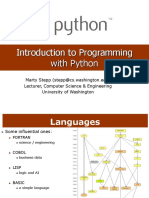0 ratings0% found this document useful (0 votes)
6 viewspython_basics_colorful_notes
The document outlines the basics of Python programming, covering topics such as variables, data types, input/output operations, control flow, operators, nested statements, functions, and library routines. It provides examples for each concept to illustrate their usage. This serves as a foundational guide for understanding Python syntax and programming logic.
Uploaded by
afraa umerCopyright
© © All Rights Reserved
We take content rights seriously. If you suspect this is your content, claim it here.
Available Formats
Download as PDF, TXT or read online on Scribd
0 ratings0% found this document useful (0 votes)
6 viewspython_basics_colorful_notes
The document outlines the basics of Python programming, covering topics such as variables, data types, input/output operations, control flow, operators, nested statements, functions, and library routines. It provides examples for each concept to illustrate their usage. This serves as a foundational guide for understanding Python syntax and programming logic.
Uploaded by
afraa umerCopyright
© © All Rights Reserved
We take content rights seriously. If you suspect this is your content, claim it here.
Available Formats
Download as PDF, TXT or read online on Scribd
You are on page 1/ 3
Python Basics - Colorful Notes According to Syllabus
1. Declare and Use Variables and Constants
Variables store data that can change.
Example:
name = 'John' # String
age = 25 # Integer
Constants are usually written in uppercase letters:
PI = 3.14159 # Constant value
2. Understand and Use Basic Data Types
Basic data types include:
- Integer: Whole numbers (e.g., 10)
- Real (float): Decimal numbers (e.g., 3.14)
- Char: Python uses strings for characters (e.g., 'A')
- String: Sequence of characters (e.g., 'Hello')
- Boolean: True or False
3. Understand and Use Input and Output
Input and output operations:
user_input = input('Enter your name: ') # Input
print('Hello, World!') # Output
4. Control Flow Concepts
(a) Sequence: Instructions executed in order.
(b) Selection (if statements): Conditional logic.
if age > 18:
print('You are an adult.')
(c) Iteration (loops):
for i in range(5):
print(i)
while count < 5:
count += 1
5. Arithmetic, Logical, and Boolean Operators
Arithmetic: +, -, *, /, %, **
Logical: ==, <, >, <=, >=, !=
Boolean: AND, OR, NOT
6. Nested Statements
Nested if statements and loops:
if age > 18:
if age < 25:
print('Young adult')
for i in range(3):
for j in range(2):
print(i, j)
7. Procedures, Functions, and Parameters
Functions: Reusable blocks of code.
def greet(name):
return f'Hello, {name}!'
Local and global variables:
global_var = 10 # Global variable
def some_function():
local_var = 5 # Local variable
8. Library Routines
Common functions:
- MOD: % for remainder
- DIV: // for integer division
- ROUND: round(3.14159, 2) # Output: 3.14
- RANDOM:
import random
random.randint(1, 10) # Random integer
You might also like
- Python_Fundamentals_Presentation nverseenNo ratings yetPython_Fundamentals_Presentation nverseen11 pages
- Beginning Programming With Python For Dummies (Mueller 2014-09-22)No ratings yetBeginning Programming With Python For Dummies (Mueller 2014-09-22)34 pages
- Sudden Python: Drinking From The Fire HoseNo ratings yetSudden Python: Drinking From The Fire Hose25 pages
- pythonCW_c1437d1e38eb4428a78560826451ef58_86525No ratings yetpythonCW_c1437d1e38eb4428a78560826451ef58_8652511 pages
- c90ac5f1-8cfe-454d-A4b5-Cb9f2f591b5bo Level Igcse Maths Paper bNo ratings yetc90ac5f1-8cfe-454d-A4b5-Cb9f2f591b5bo Level Igcse Maths Paper b15 pages
- f7b22ac0 Dea7 4535 a296 e66a47ff6c2fo Level Igcse Physics TheoryNo ratings yetf7b22ac0 Dea7 4535 a296 e66a47ff6c2fo Level Igcse Physics Theory18 pages
- Ba299076-72b9-425c-Ab2b-2de539c87a00o Level Igcse Computer Science TheoryNo ratings yetBa299076-72b9-425c-Ab2b-2de539c87a00o Level Igcse Computer Science Theory6 pages




































































